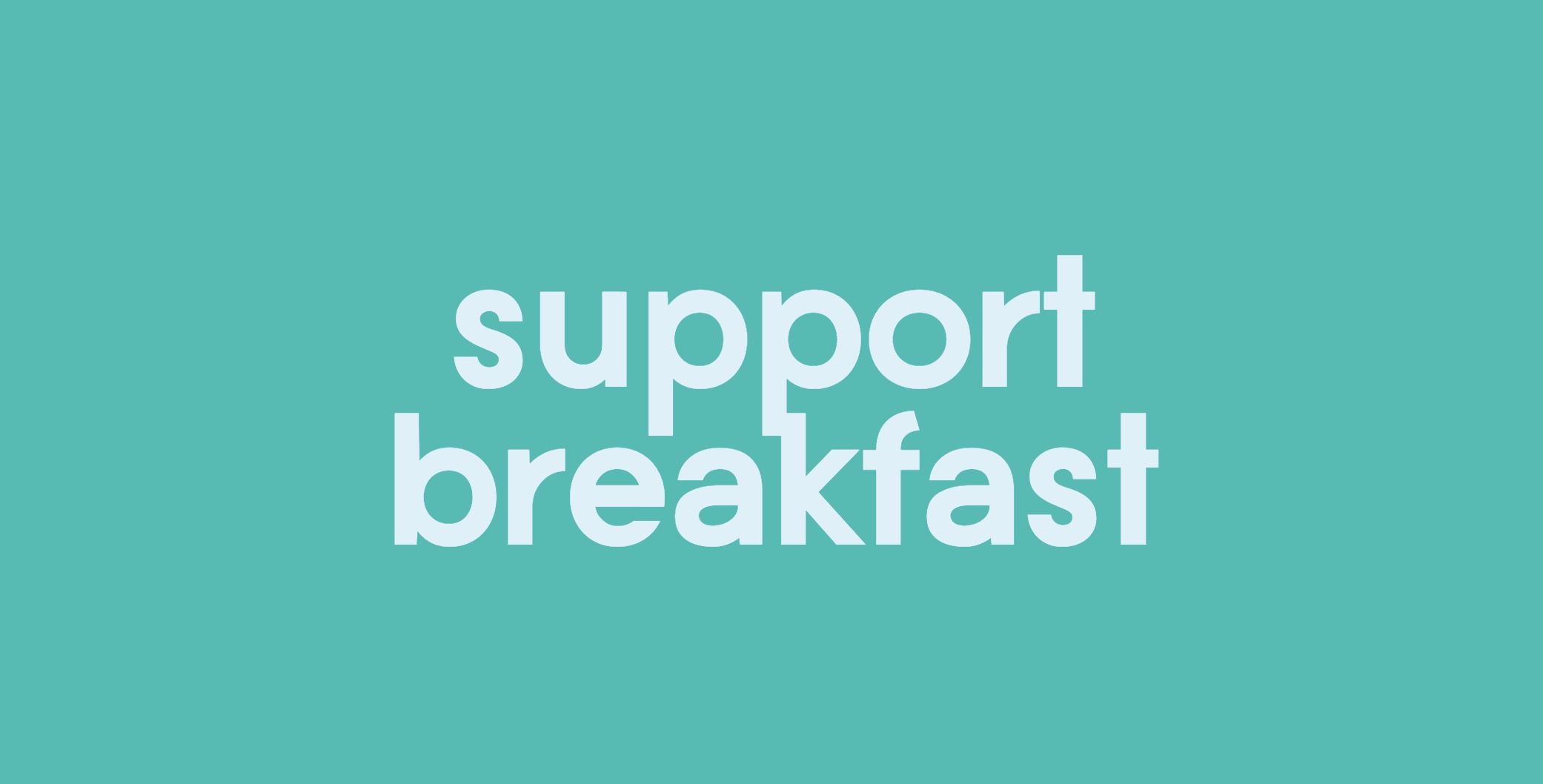Recipes and Cooking Tips
What Is Healthy Breakfast for Diabetics? Manage Your Blood Sugar Effectively!
Manage your blood sugar effectively with a nutritious breakfast; discover the essential components that can make a significant difference in your health.
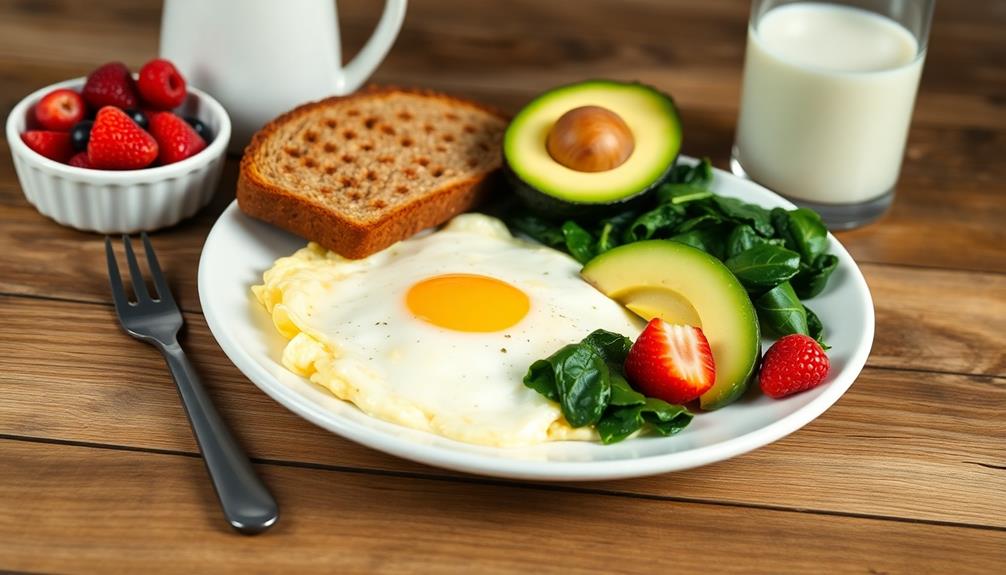
A healthy breakfast for diabetics is essential for managing blood sugar effectively. Start with protein-rich foods like eggs, Greek yogurt, or cottage cheese to stabilize your levels. Add high-fiber options such as chia seeds, whole grains, or fruits to slow carbohydrate absorption and promote fullness. Healthy fats, like those from avocados or nuts, enhance insulin sensitivity. Try combining these elements for balanced meals, like an avocado egg toast or overnight oats. Avoid refined carbs and sugary foods, as they can spike your blood sugar. Explore more delicious and nutritious options to support your health journey.
Key Takeaways
- A healthy breakfast for diabetics should include protein-rich foods like eggs or Greek yogurt to stabilize blood sugar levels.
- Incorporate high-fiber options such as whole grains or fruits to slow carbohydrate absorption and promote fullness.
- Combine healthy fats from sources like avocados and nuts to enhance insulin sensitivity and support heart health.
- Opt for low-glycemic index carbohydrates, such as sweet potatoes or legumes, to prevent rapid blood sugar spikes.
- Plan and prepare meals in advance, focusing on nutrient-dense ingredients to maintain effective blood sugar control.
Importance of a Healthy Breakfast
Starting your day with a healthy breakfast is essential for managing diabetes effectively. It stabilizes your blood sugar levels after fasting overnight, which is vital for overall diabetes management. When you consume a nutrient-dense breakfast within an hour of waking, you restore energy levels and counteract cortisol-induced blood sugar drops.
Skipping breakfast, on the other hand, can increase your risk of type 2 diabetes and may result in overeating later, leading to blood sugar spikes.
By regularly enjoying a healthy breakfast, you can enhance your dietary patterns and support weight management. Focus on meals that boost insulin sensitivity and contain low-glycemic foods. Avoid high-glycemic foods in the morning, as they can cause fluctuations in blood sugar levels throughout the day.
Incorporating a variety of nutrient-dense foods not only aids in blood sugar metabolism but also improves your overall metabolic function.
Key Nutrients for Blood Sugar Control
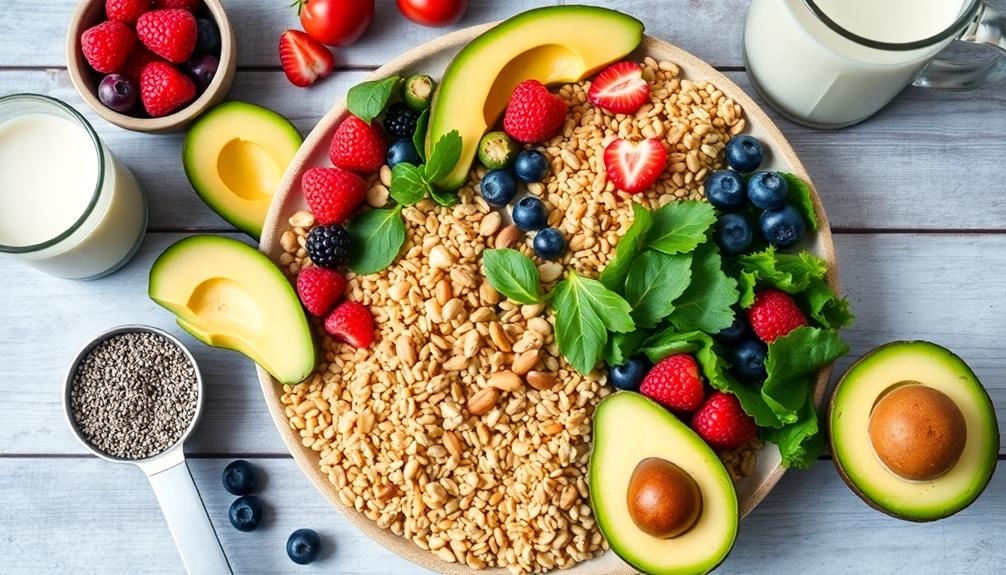
For effective blood sugar control, focusing on key nutrients in your breakfast can make a significant difference. Incorporating protein, fiber, healthy fats, and low glycemic index carbohydrates can help stabilize your blood sugar levels and promote overall health.
| Nutrient | Benefits | Examples |
|---|---|---|
| Protein | Stabilizes blood sugar; promotes satiety | Eggs, Greek yogurt |
| Fiber | Slows carbohydrate absorption; aids digestion | Chia seeds, whole grains |
| Healthy Fats | Enhances insulin sensitivity; lowers cholesterol | Avocados, nuts |
Choosing complex carbohydrates with a low glycemic index, like sweet potatoes and legumes, helps prevent rapid spikes in blood sugar. Additionally, don't overlook the importance of micronutrients found in nuts and seeds, such as magnesium and chromium, which support blood sugar metabolism and improve insulin action.
Protein Sources for Breakfast
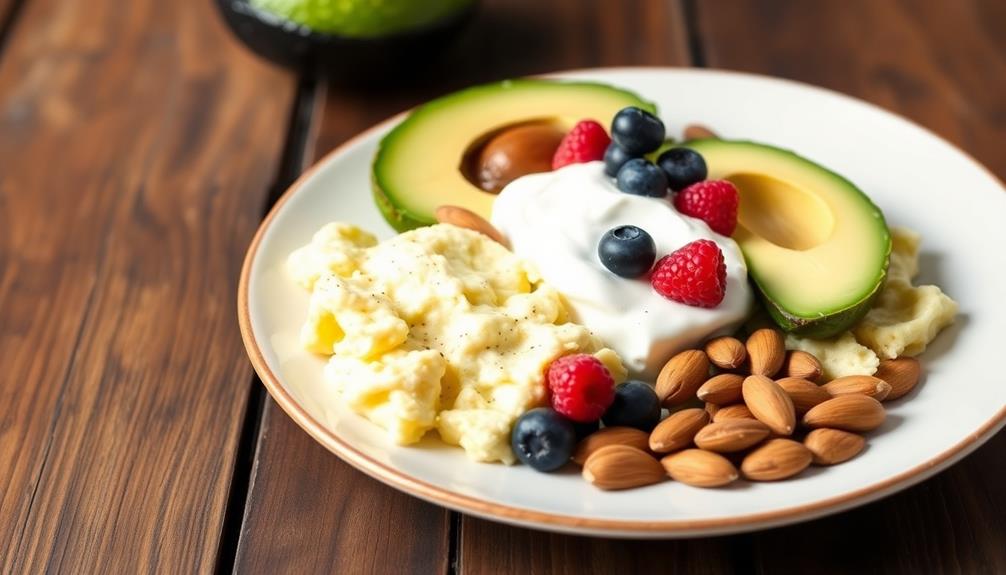
When you start your day with protein, you can help stabilize your blood sugar levels and curb hunger.
Some of the best protein sources for breakfast include eggs, Greek yogurt, and nuts, which not only offer great taste but also provide essential nutrients.
Combining these proteins with healthy carbs can create balanced meals that keep your energy steady throughout the morning.
Benefits of Protein Intake
Incorporating protein-rich foods into your breakfast can considerably enhance blood glucose control while keeping you feeling fuller longer. Foods like Greek yogurt and eggs are excellent choices that promote satiety, which can help reduce overall calorie intake.
Easy Keto Breakfast Ideas showcase how nutritious options can be both delicious and beneficial for managing diabetes. Studies show that higher dietary protein intake is linked to better glucose responses, especially for individuals with type 2 diabetes. Consuming five eggs weekly has even been associated with a reduced risk of developing prediabetes and type 2 diabetes, showcasing the importance of including protein in your meals.
Nuts and seeds are another fantastic option, as they're packed with both protein and healthy fats. These nutrients help regulate insulin and glucagon levels, aiding in effective blood sugar management.
By adding these protein-rich foods to your breakfast, you can considerably improve insulin sensitivity, making it easier to control your glucose levels throughout the day. Whether it's a bowl of Greek yogurt topped with nuts or a hearty omelet, prioritizing protein at breakfast sets a positive tone for your blood glucose control and overall health.
Embrace these protein benefits to empower your dietary choices!
Best Protein Sources
Starting your day with a protein-packed breakfast can greatly benefit your blood sugar management and overall health. The best protein sources not only provide essential nutrients but also support insulin sensitivity and blood sugar control.
Here are three excellent options to contemplate for a diabetic-friendly breakfast:
- Eggs: Rich in protein, eggs can aid in blood glucose control. Research suggests that consuming five eggs weekly may lower your risk of prediabetes and type 2 diabetes.
- Greek Yogurt: This high-protein choice is packed with probiotics, enhancing gut health and improving insulin sensitivity. Pair it with berries for a delicious start to your day.
- Nuts and Seeds: These are loaded with vitamins, minerals, and heart-healthy fats. Studies show that they help regulate insulin and glucagon levels, supporting blood sugar balance.
Incorporating high-protein foods like cottage cheese or lean protein can also help stabilize blood sugar levels when eaten with carbohydrates.
A protein-rich breakfast not only promotes satiety but also reduces cravings throughout the day, making it easier for you to manage your health effectively.
Combining Protein With Carbs
Combining protein with carbohydrates at breakfast can greatly enhance your satiety levels, making it easier to manage your appetite throughout the day. This strategy not only helps control your blood sugar but also stabilizes your blood glucose levels.
High-protein foods like eggs and Greek yogurt are particularly effective. Research shows that including protein alongside carbohydrates results in a lower post-meal blood glucose spike compared to meals that consist only of carbs.
For a balanced breakfast, consider whipping up an omelet filled with veggies or enjoying a yogurt parfait layered with fruits and nuts. These protein sources provide essential nutrients, fiber, and healthy fats, all contributing to better insulin sensitivity, which is crucial for managing diabetes.
Nuts and seeds can also be great additions, offering extra crunch and nutrition.
High-Fiber Breakfast Options
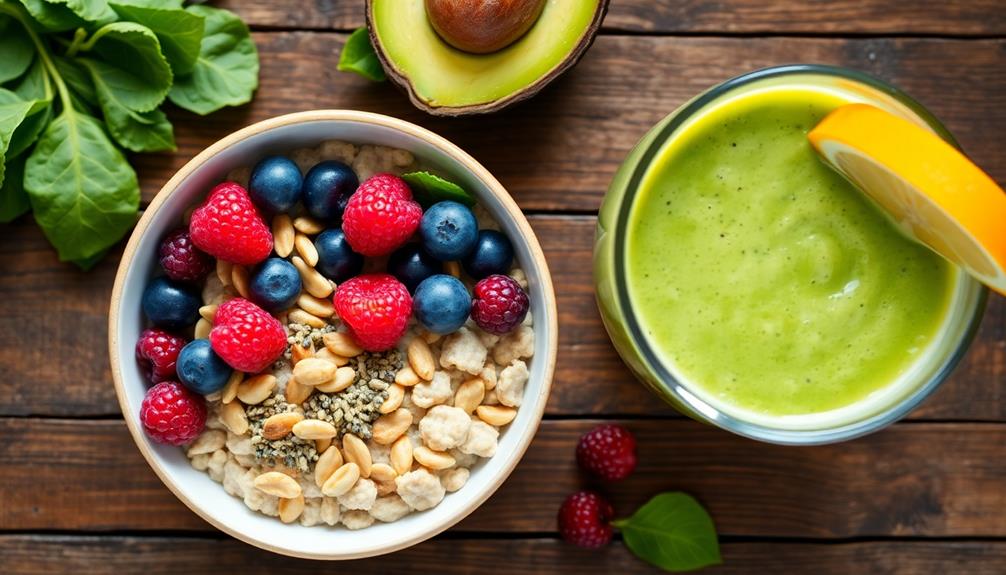
When it comes to managing diabetes, high-fiber breakfast options are a game-changer. They not only help stabilize your blood sugar levels but also keep you feeling full longer.
Let's explore the benefits of fiber-rich foods, some tasty examples, and handy meal prep tips to get you started.
Benefits of High Fiber
How can a high-fiber breakfast transform your morning routine? By incorporating high-fiber foods into your meals, you can manage your blood sugar levels more effectively and support diabetes control.
High-fiber breakfasts, featuring whole grains, fruits, and vegetables, slow down carbohydrate absorption, helping to prevent spikes in blood sugar. Additionally, boosting your fiber intake can enhance satiety, reducing overall calorie consumption, which is essential for weight management.
Here are three benefits of starting your day with high-fiber options:
- Improved Glycemic Control: A diet rich in fiber is linked to better glycemic control, reducing the risk of type 2 diabetes.
- Enhanced Insulin Sensitivity: Soluble fiber, found in oats and legumes, improves insulin sensitivity, helping you manage blood sugar more effectively.
- Increased Satiety: High-fiber breakfasts keep you feeling full longer, which can help you control cravings and maintain a healthy weight.
Fiber-Rich Foods Examples
Starting your day with high-fiber breakfast options not only supports blood sugar management but also sets a positive tone for your overall health. Incorporating fiber-rich foods into your morning routine can help slow down digestion, preventing rapid blood sugar spikes.
Some excellent choices include oatmeal, which is packed with soluble fiber, and whole grain bread. These high-fiber foods improve insulin sensitivity and promote satiety, making them ideal for diabetes management.
Consider overnight oats topped with berries, which aren't only high in fiber but also low on the glycemic index. You might also want to include fruits like apples or pears in your breakfast, as they provide essential nutrients along with their fiber content.
Vegetables, such as spinach or tomatoes, can be added to omelets for an extra fiber boost.
Don't forget about legumes! Adding lentils or beans to your morning meals greatly enhances fiber content and provides valuable nutrients that benefit blood sugar control.
Aim for a daily fiber intake of 25-30 grams, and you'll be well on your way to managing your diabetes more effectively.
Meal Prep Tips
Meal prepping high-fiber breakfast options can make a significant difference in managing your diabetes effectively. By incorporating whole grains and fiber-rich ingredients, you can enhance your glycemic management and support stable blood sugar levels throughout the day.
Here are some meal prep tips to get you started:
- Overnight Oats: Combine steel-cut oats with chia seeds and your choice of milk. Add fruits and nuts for extra fiber and taste. Leave it in the fridge overnight for a quick, nutrient-rich breakfast.
- Veggie Frittatas: Whisk eggs with spinach, bell peppers, or other vegetables. Pour into a muffin tin and bake. These can be stored in the fridge for portion-controlled breakfasts that are high in fiber.
- Whole Grain Wraps: Fill whole grain tortillas with lentils, beans, or roasted vegetables. These wraps are easy to prepare ahead of time and provide a great balance of carbohydrates and fiber.
Breakfast Recipe Ideas

A variety of delicious and nutritious breakfast options can help you manage diabetes while satisfying your taste buds. Start your day with Avocado Egg Toast on whole grain bread. This combo provides healthy fats, fiber, and protein, all essential for stabilizing blood sugar levels.
For a revitalizing twist, try Very Berry Yogurt. Mix plain Greek yogurt with frozen berries for a low-carb, high-protein breakfast that supports glycemic control.
If you're in the mood for something sweet, whip up Chocolate Chia Seed Pudding. Using chia seeds, almond milk, and cocoa powder, this high-fiber treat keeps blood sugar steady and fills you up.
Smoothie Variations are another excellent choice. Blend low-glycemic fruits, leafy greens, and a scoop of Greek yogurt or protein powder for a nutrient-packed drink.
Finally, don't overlook Oatmeal with Toppings. Steel-cut oats topped with nuts, seeds, or fresh fruit provide a fiber-rich breakfast that fuels you throughout the morning while managing blood sugar levels effectively.
These healthy breakfast options won't only nourish you but also keep your energy stable. Enjoy!
Foods to Avoid

When managing diabetes, it's crucial to be mindful of certain foods that can negatively impact your blood sugar levels. By avoiding these foods, you can better maintain blood sugar control and reduce the risk of high blood sugar spikes.
Here are three key foods to avoid:
- Refined Carbohydrates: Foods like white toast, packaged muffins, French toast, and pancakes made with white flour have low fiber content. These can cause rapid spikes in your blood sugar levels.
- Sugar-Sweetened Beverages: Drinks such as juices and sodas lead to quick increases in blood glucose and offer little nutritional value. It's best to limit these to keep your blood sugar stable.
- Processed Snacks and Baked Goods: Many processed snacks and baked goods contain hidden added sugars and unhealthy fats. These can contribute to blood sugar instability, making them foods to avoid in your breakfast choices.
Strategies for Optimal Blood Sugar Management

Effective blood sugar management involves a combination of smart eating strategies and lifestyle choices. To keep your blood sugar levels stable, focus on incorporating healthy foods rich in dietary fiber and protein. Whole grains, legumes, and vegetables are excellent choices that slow carbohydrate absorption and enhance insulin sensitivity.
Here's a quick table to guide your meal planning:
| Meal Component | Recommended Foods | Benefits |
|---|---|---|
| Protein | Eggs, Greek yogurt, nuts | Increases satiety, stabilizes blood sugar |
| Complex Carbohydrates | Oats, quinoa, brown rice | Slower absorption, lower spikes |
| Low-Glycemic Foods | Non-starchy vegetables, berries | Maintains consistent glucose levels |
Regularly scheduled meals and snacks are essential. They help you avoid hyperglycemia and promote better overall control of your blood sugar. By planning your meals in advance, you can stick to a diabetes-friendly diet and limit unhealthy choices. Remember to prioritize foods that support effective blood sugar management, ensuring you stay healthy and energized throughout the day.
Frequently Asked Questions
What Is the Best Breakfast to Lower Blood Sugar Levels?
To lower blood sugar levels, opt for a breakfast rich in protein and fiber. Include whole grains, healthy fats, and low-glycemic fruits. This combination helps stabilize your blood sugar and keeps you satisfied longer.
What Is the First Thing a Diabetic Should Eat in the Morning?
Did you know that eating breakfast within an hour of waking can lower blood sugar levels? Start your day with protein-rich foods, healthy fats, and high-fiber options to keep your energy balanced and stable.
What Can I Eat in the Morning to Not Spike My Blood Sugar?
To avoid spiking your blood sugar in the morning, consider eating eggs or Greek yogurt with whole-grain toast. Add some avocado or chia seeds for fiber, and steer clear of sugary cereals and pastries.
What Is the One Food That Lowers Blood Sugar?
One food that effectively lowers blood sugar is eggs. When you include eggs in your diet, you promote satiety and improve glucose response, potentially reducing your risk of prediabetes and type 2 diabetes.
Conclusion
Incorporating a healthy breakfast into your routine can be a game-changer for managing blood sugar levels. By focusing on key nutrients, protein sources, and high-fiber options, you can set yourself up for success each day. Remember, it's not just about what you eat but also about making smart choices and avoiding certain foods. So, take the bull by the horns and start your mornings right—your body will thank you for it!
Recipes and Cooking Tips
What Are Healthy Breakfast Cereals? Choose the Best Options for a Nutritious Morning!
The best healthy breakfast cereals can transform your morning routine—discover what to look for to fuel your day effectively!
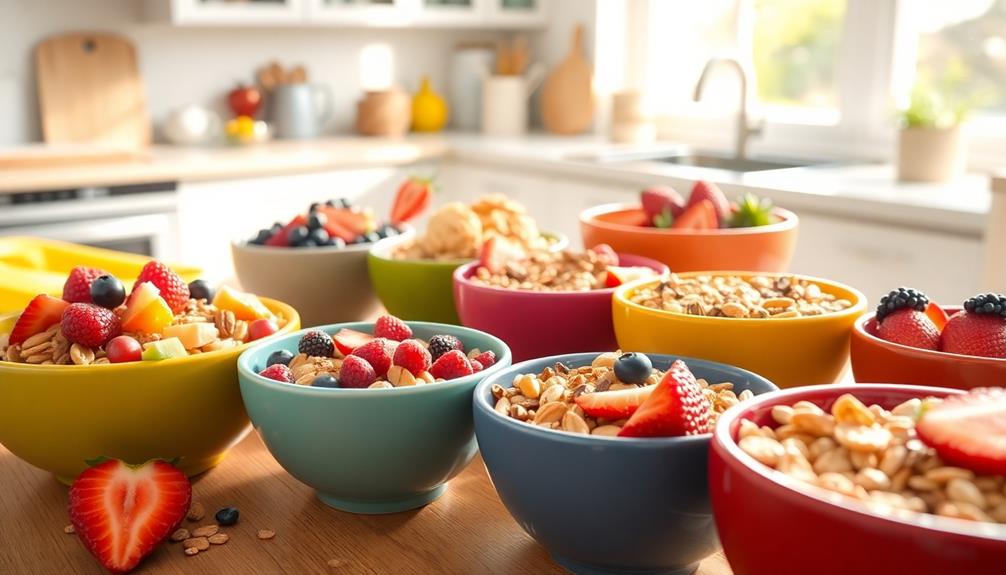
Healthy breakfast cereals can set you up for a nutritious morning. Look for options with whole grains as the first ingredient and at least 5 grams of fiber per serving. Avoid cereals high in added sugars—stick to 5 grams or less to maintain steady energy. Brands like Barbara's Shredded Wheat and Uncle Sam Original Wheat Berry Flakes offer great fiber with minimal sugar. Check the sodium level too; 200 mg or less is best for heart health. With the right choices, you can boost your breakfast game and feel great all day—find out more about your options!
Key Takeaways
- Choose cereals with whole grains as the first ingredient for essential fiber and nutrients.
- Aim for at least 5 grams of fiber and 5 grams of added sugars or less per serving.
- Avoid cereals high in added sugars to maintain stable energy levels and prevent crashes.
- Look for low sodium options (200 mg or less) to support heart health.
- Consider brands like Barbara's Shredded Wheat or Uncle Sam for high fiber content and minimal ingredients.
Importance of Healthy Cereal Choices
When it comes to breakfast, cereal is a staple in many households, but not all cereal choices are created equal. With nearly 300 million Americans consuming cereal daily, the impact of these choices on health can't be overstated. Many commercially available cereals are loaded with added sugars and lack essential nutrients, which can lead to poor dietary habits.
To make a healthy choice, you need to scan the nutrition facts on package labels carefully. Misleading branding often masks what's truly inside.
Opting for cereals that prioritize whole grains and have minimal processing is essential for your health. Look for options that contain at least 5 grams of fiber per serving; this not only aids digestion but also helps maintain stable blood sugar levels.
Avoid those high in added sugar, as they contribute to health risks over time. Remember, not all packaged foods are created equal—some are packed with nutrients while others are just empty calories.
Key Nutritional Components
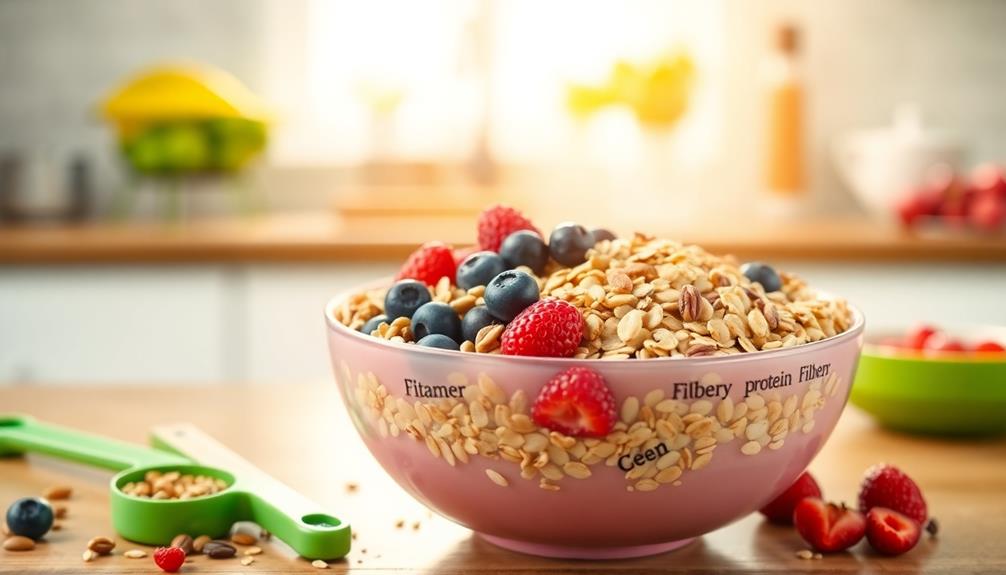
When choosing a breakfast cereal, look for whole grains as the first ingredient, since they pack essential fiber and nutrients.
Aim for cereals with at least 5 grams of fiber per serving while keeping added sugars to 5 grams or less.
This way, you'll fuel your body with the right nutrition while keeping your health on track.
Whole Grains Importance
Whole grains are often the foundation of a nutritious breakfast, providing key components essential for your health. When selecting a healthy cereal, look for whole grains listed as the first ingredient on the packaging. This guarantees you're getting essential nutrients such as fiber, protein, magnesium, and selenium, which are often lost during processing.
Including whole grains in your diet is linked to a lower risk of heart disease and diabetes, making them an important part of a healthy breakfast. Many healthy cereals contain at least 5 grams of fiber per serving, which aids in digestion and helps you feel fuller for longer. This fiber is integral for maintaining muscle and nerve function, emphasizing its significance in supporting overall health and well-being.
Be cautious with terms like "multigrain," as these don't assure whole grain content. Always check the ingredient list to verify that whole grains are prominent.
Sugar and Fiber Content
A healthy breakfast cereal should strike a balance between sugar and fiber content to support your overall well-being. Ideally, you want cereals with 5 grams of added sugars or less per serving. This helps promote better health and reduces excess calorie intake. High sugar levels can lead to energy crashes and contribute to health issues, so steer clear of cereals labeled with terms like "crunch," "clusters," or "fruity," as they often contain more sugar than you'd like.
On the flip side, aim for cereals that provide at least 5 grams of fiber per serving. Fiber is essential for digestive health and keeps you feeling full longer, which can help with weight management. Look for cereals where whole grains are the first ingredient. Whole grains offer more fiber, protein, and essential nutrients compared to refined grains, enhancing your breakfast's nutritional value.
Don't forget to check sodium levels, too; healthy cereals should ideally contain 200 mg of sodium or less per serving to support heart health.
Whole Grains and Their Benefits

Whole grains pack a nutritional punch, offering essential nutrients that refined grains often lack.
You'll find that their high fiber content plays a vital role in digestion and helps keep you feeling full longer.
Nutritional Value Overview
Nutrient-dense, whole grains offer numerous health benefits that can enhance your breakfast choices. They're rich in fiber and important nutrients, helping you lower the risk of heart disease and diabetes while promoting digestive health.
When you prioritize whole grains in your breakfast, you contribute to a healthy diet that supports lower cholesterol levels and improved blood sugar control. Additionally, incorporating natural remedies such as healthy fats from nuts or seeds can further enhance your breakfast's nutritional profile.
Specific cereals, like Ezekiel 4:9 Sprouted Grain Cereals, not only provide a good source of protein but also enhance nutrient absorption due to their sprouting process. Opting for whole grain cereals can considerably boost your daily fiber intake, helping you reach the recommended 25-30 grams for adults.
Unlike processed grains, whole grain options offer better nutrient profiles and additional health benefits, such as omega-3 fatty acids.
Moreover, many whole grain cereals contain lower grams of sugar compared to their refined counterparts, making them a smarter choice for your morning meal.
Fiber's Role Explained
Fiber plays an essential role in your diet, often going unnoticed despite its numerous benefits. Including whole grains in your breakfast cereal can notably enhance your dietary fiber intake, which is vital for digestion and maintaining stable blood sugar levels. This can help reduce your risk of heart disease and diabetes.
A fiber-rich diet not only improves satiety but also aids in weight management, as it keeps you feeling full longer, preventing overeating. Adults should aim for about 25-30 grams of fiber daily, yet many fall short of these guidelines.
Choosing cereals made from whole grains, like oats and barley, is a smart way to boost your intake. These grains contain beta-glucan, a soluble fiber known to lower cholesterol levels when consumed in adequate amounts—around 3 grams per day.
Cereals like Barbara's Shredded Wheat and Post Foods Grape Nuts offer impressive fiber content, providing 7 grams per serving. By incorporating these whole grain breakfast cereals into your diet, you can easily meet your daily fiber needs while enjoying a nutritious start to your day with healthy fats and essential nutrients.
Whole Grains vs. Refined
Choosing whole grains over refined grains can greatly enhance your breakfast options. Whole grains retain the bran, germ, and endosperm, providing essential nutrients, fiber, and antioxidants that refined grains lack. A diet rich in whole grains can lower your risk of heart disease, type 2 diabetes, and certain cancers, thanks to their high fiber content and beneficial phytochemicals.
Whole grains, like oats, offer around 4 grams of fiber per cooked cup, aiding digestion and helping you feel full. Plus, they help maintain stable blood sugar levels due to their lower glycemic index compared to refined grains, which can spike your blood sugar.
Here's a quick comparison of whole grains and refined grains:
| Feature | Whole Grains | Refined Grains |
|---|---|---|
| Nutritional Value | High in fiber, nutrients, and antioxidants | Low in fiber, often stripped of nutrients |
| Blood Sugar Impact | Lower glycemic index | Higher glycemic index |
| Examples | Oats, barley, quinoa | White rice, white bread |
Incorporating whole grain breakfast cereals, like Barbara's Shredded Wheat or Post Foods Grape Nuts, can lead to more nutritious mornings.
Sugar Awareness in Cereals
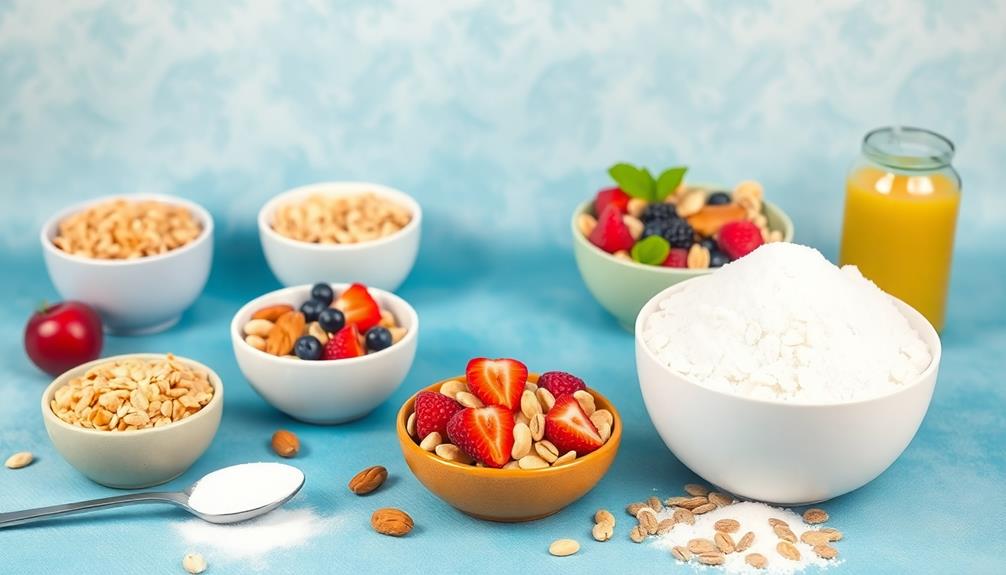
When you pick up a box of cereal, it's important to be aware of the hidden sugars lurking inside. Many packaged cereals are high in sugar, often containing more than 8 grams of added sugar per serving. This can lead to unhealthy eating habits that might affect your overall health.
To make smarter choices, start by reading labels carefully. Look for ingredients like dextrose and maltose—they're just forms of added sugar often found in cereals. Aim for cereals with 5 grams of added sugar or less per serving.
Watch out for terms like "crunch," "clusters," or "fruity," as these often indicate higher sugar content. Being mindful of these factors is essential for maintaining a healthy breakfast routine.
Monitoring sugar intake is critical, as excessive consumption can contribute to weight gain and increase your risk of chronic diseases like diabetes and heart disease. By choosing cereals wisely, you can enjoy a nutritious start to your day without the unnecessary sugar overload.
High Fiber Options

Many people overlook the importance of fiber in their breakfast cereals, especially after being mindful of sugar content. High-fiber cereals are essential for a nutritious morning, helping you meet your daily fiber intake goal of 25-30 grams. Options like Barbara's Shredded Wheat and Post Foods Grape Nuts each provide 7 grams of fiber per serving, supporting digestive health and promoting satiety.
If you're looking for a more substantial fiber boost, Bob's Red Mill Paleo-Style Muesli delivers an impressive 16% of your daily fiber needs in just one serving. Incorporating such high-fiber cereals into your healthy breakfast can greatly impact your overall health.
These cereals not only aid in digestion but also help in maintaining stable blood sugar levels and lowering cholesterol levels, promoting heart health.
When selecting a cereal, aim for those with at least 5 grams of fiber per serving. Whole grain options are particularly beneficial, as they provide additional nutrients that contribute to your well-being.
Recommended Healthy Cereals
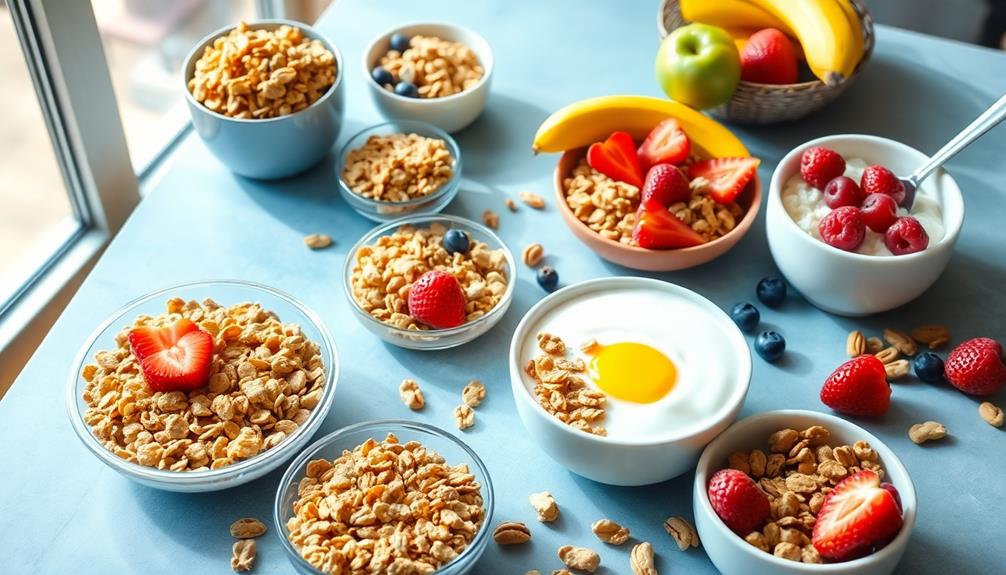
A nutritious breakfast starts with selecting the right cereal, and there are plenty of healthy options to fuel your morning. One great choice is Alpen No Sugar Added Muesli, which offers 210 calories and 7g of fiber per serving, all with no added sugar.
If you're looking for something high in protein, consider Bob's Red Mill Protein Oats; at 190 calories, they provide 5g of fiber and also contain no added sugar.
For a whole grain option, check out Uncle Sam Original Wheat Berry Flakes. With 220 calories and a whopping 10g of fiber, they're not only filling but also rich in omega-3 fatty acids.
Another excellent pick is Nature's Path Organic Flax Plus Multibran Flakes, which give you 150 calories, 7g of fiber, and only 5g of added sugar.
Lastly, Barbara's Shredded Wheat Cereal is a fantastic single-ingredient option. It contains just 170 calories and 7g of fiber, making it a wholesome choice for your healthy breakfast without any added sugar.
Choosing these cereals helps you start your day right!
DIY Cereal Recipes

Creating your own cereal at home not only lets you customize flavors but also guarantees you're fueling your body with wholesome ingredients.
DIY cereals can be both delicious and nutritious, allowing you to control what goes into your breakfast. Here are a few ideas to get you started:
- Muesli: Combine rolled oats, nuts, seeds, and dried fruit for a filling option that suits your taste.
- Granola: Mix rolled oats with nuts, seeds, and a natural sweetener like honey or maple syrup, then bake until golden for a crunchy treat.
- Cinnamon Crunch: Create a simple cereal by blending oats with cinnamon and a touch of sweetener, then bake until crispy. This offers a healthier alternative to store-bought versions.
- Peanut Butter Puffs: Mix oats with natural peanut butter and a sweetener before baking for a protein-rich breakfast option that keeps you satisfied.
For a fiber-packed choice, try a Flax Chia Cereal made from ground flaxseed, chia seeds, and rolled oats.
Each of these DIY cereals not only tastes great but also supports your health goals!
Breakfast Habits for Wellness
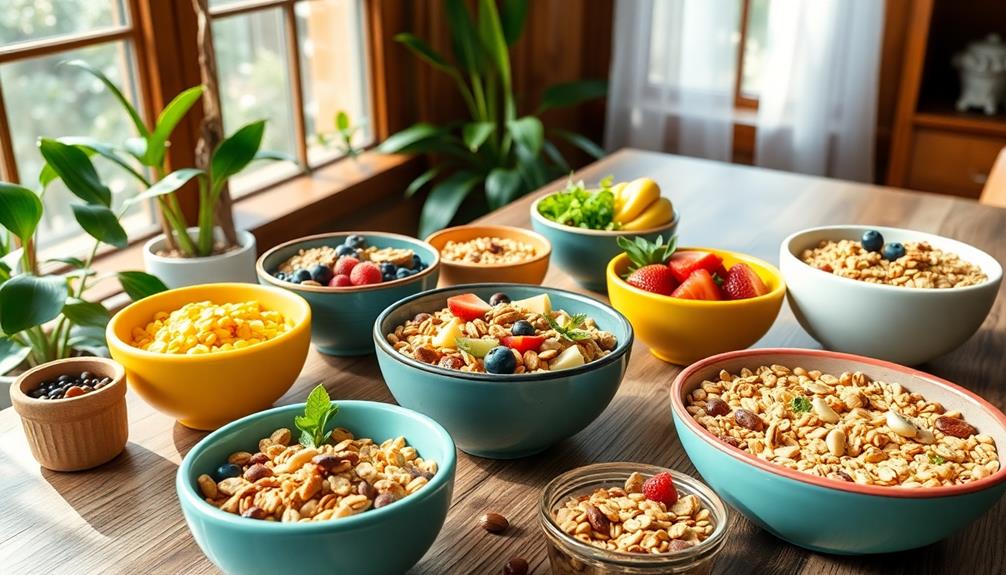
Starting your day with a healthy breakfast sets the tone for better choices throughout the day. Regular breakfast consumption not only boosts your cognitive function but also helps with weight maintenance, making it essential for your daily wellness.
A nutritious breakfast, especially one rich in whole grains and fiber, supports digestive health and keeps your blood sugar levels stable.
Many Americans struggle to meet the recommended daily fiber intake of 25-30 grams, which is where high-fiber cereals can play a significant role. By choosing cereals packed with whole grains, you'll improve your fiber intake considerably.
Don't forget to include nuts and fruits for added nutrients and flavor.
Monitoring portion sizes is also critical; typical cereal servings range from 1/4 to 1 cup. Being mindful of these portions can help you manage calorie control and enhance your overall dietary intake.
Incorporating a variety of healthy breakfast options will provide a balanced start to your day, setting the foundation for long-term health. Embrace these habits, and you'll likely feel the positive effects throughout your day!
Frequently Asked Questions
What Is the Healthiest Cereal to Eat Every Morning?
To find the healthiest cereal for your mornings, look for options with whole grains, at least 5 grams of fiber, and low sugar content. Reading labels helps you choose the best, nutritious choices easily.
What Is the Number 1 Breakfast Cereal?
When you think of breakfast comfort, oatmeal often tops the list. With its creamy texture and fiber-packed goodness, it's like a warm hug for your stomach, making it the number one breakfast cereal choice.
What Is the Best Cereal to Eat in the Morning to Lose Weight?
To lose weight, you should choose cereals high in fiber and low in added sugars. Opt for whole grains and protein-rich options, and be mindful of portion sizes to effectively manage your calorie intake.
Which Cereals Do You Usually Eat Everyday?
You are what you eat, so choose wisely! If you're eating cereals daily, pick those high in fiber and low in sugar. Whole grain options like Shredded Wheat can boost your morning energy and health.
Conclusion
As you navigate the cereal aisle, think of it as a journey through a vibrant forest. Each box represents a different path, some leading to energy and liveliness, while others may lead you astray. By choosing whole grains, high fiber, and low sugar options, you're picking the trail that nurtures your body and mind. So, embrace the adventure of healthy breakfast cereals, for every mindful choice you make plants the seeds for a flourishing day ahead.
Recipes and Cooking Tips
Are Clif Bars a Healthy Breakfast? Here’s What You Should Know!
Can Clif Bars truly fuel your morning, or are they just a sugary snack in disguise? Discover the surprising truth about your breakfast choices!

Clif Bars aren't the healthiest breakfast choice, even though they're convenient. Each bar packs roughly 240 calories, but with 17 grams of sugar and only 10 grams of protein, they may cause energy spikes followed by crashes. They're designed more as snacks for athletes rather than complete meals. You might feel full due to the 5 grams of fiber, but that won't last. Instead of relying on Clif Bars for breakfast, consider options with balanced nutrients to keep you energized throughout the day. Keep exploring to discover healthier alternatives that could better support your morning routine.
Key Takeaways
- Clif Bars contain high sugar levels (17 grams), which can lead to energy spikes and crashes, making them less ideal for breakfast.
- Each bar provides only 10 grams of protein, falling short of the recommended intake for a balanced meal.
- With 240 calories, Clif Bars generally do not meet the standard caloric needs for a complete breakfast (300-500 calories).
- They are designed for athletes as pre- or post-workout fuel, not as a nutritious breakfast replacement.
- Alternative options like Greek yogurt or mixed nuts offer better nutritional profiles for a healthy breakfast.
Clif Bar Overview
Clif Bars are often recognized as a go-to option for those seeking a quick and nutritious snack, especially for athletes on the move. Founded in 1992, Clif Bar & Company emerged from a bike ride, with the first flavors debuting at a bike show in 1991. By 1997, the company rebranded as Clif Bar, Inc., achieving over $20 million in revenue, showcasing their rapid growth in the healthy snack market.
Each Clif Bar packs approximately 240 calories, primarily designed to provide sustained energy during physical activities. You'll find about 10 grams of protein and 43 grams of carbohydrates, thanks to ingredients like rolled oats and soy protein isolate.
However, it's important to note that these bars contain 17 grams of total sugars, which include added sugars. While Clif Bars can be convenient, it's wise to be mindful of the sugar content if you're watching your intake.
Clif Bar & Company is also committed to sustainability, sourcing 70% of their ingredients as certified organic and ensuring 100% cocoa comes from Rainforest Alliance Certified farms since 2012. This commitment is another reason many enjoy Clif Bars as part of their active lifestyle.
Nutritional Breakdown

With each Clif Bar delivering a substantial 240 calories, it's easy to see why many choose them as a quick breakfast option. Here's a closer look at the nutritional breakdown of Clif Bars:
| Nutrient | Amount per Bar | Daily % Value |
|---|---|---|
| Calories | 240 | 12% |
| Protein | 10 grams | 19% |
| Carbohydrates | 43 grams | 14% |
| Added Sugar | 16 grams | – |
| Fiber | 5 grams | – |
As you can see, each bar contains 10 grams of protein, mainly from soy sources, which helps fuel your morning. The 43 grams of carbohydrates, primarily from rolled oats, provide energy, but be mindful of the 16 grams of added sugars included in this mix. On the upside, Clif Bars also pack a decent 5 grams of fiber, aiding your digestion and keeping you fuller longer. Additionally, with 6 grams of healthy fats, they offer a balanced profile to kickstart your day. Just be sure to take this nutritional information into account in the context of your overall diet.
Sugar Content Analysis
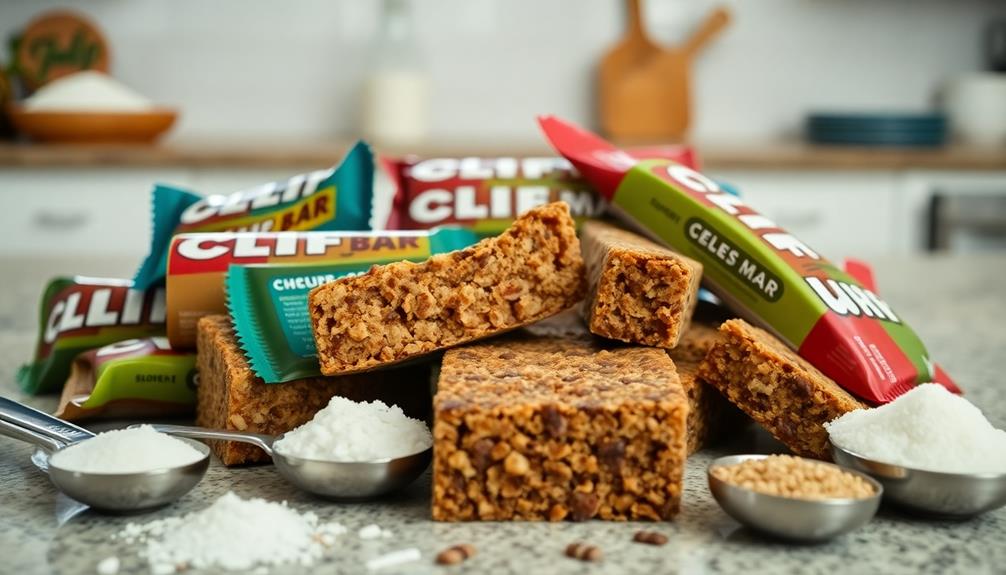
When you check the sugar content in Clif Bars, you'll find a hefty 17 grams per bar, mostly from added sugars like organic brown rice syrup and organic cane syrup.
This high sugar level can lead to quick energy spikes, but it also raises concerns about their overall nutritional value.
Let's explore the sources of this sugar, the potential health implications, and some healthier snack alternatives.
Sugar Sources Explained
Understanding the sugar sources in Clif Bars reveals a significant amount of added sugars that can impact your diet. Each bar contains a total of 17 grams of sugars, with 16 grams classified as added sugars. These come primarily from ingredients like organic brown rice syrup, organic tapioca syrup, and organic cane syrup. This high sugar content can make Clif Bars comparable to candy bars regarding nutritional value.
Here's a breakdown of the sugar sources in Clif Bars:
| Sugar Source | Amount (grams) |
|---|---|
| Organic Brown Rice Syrup | 8 |
| Organic Tapioca Syrup | 5 |
| Organic Cane Syrup | 3 |
| Total Added Sugars | 16 |
| Total Sugars | 17 |
While added sugars can provide a quick energy boost, they may compromise your balanced diet. The first ingredient is sugar, raising concerns about nearing the American Heart Association's daily recommended limit for both men and women. When choosing a breakfast option, consider how these sugars affect your overall nutrition and energy levels throughout the day.
Health Implications
The high sugar content in Clif Bars poses significant health implications that warrant attention. Each bar contains 17 grams of sugar, with 16 grams classified as added sugars. This amount is nearly at the maximum daily limit recommended by the American Heart Association, meaning you're consuming a hefty dose of sugar first thing in the morning.
The sugar primarily comes from organic brown rice syrup and organic cane syrup, serving more as binding agents than as beneficial nutrients. This quick influx of sugar can lead to spikes in your blood sugar levels, causing energy surges followed by crashes.
Regularly consuming such high-sugar products can contribute to chronic high blood sugar levels and increase the risk of insulin resistance and type 2 diabetes. Additionally, with a nutritional profile comparable to candy bars, Clif Bars may not offer the balanced breakfast you're looking for.
While they might be convenient, the potential health risks tied to the high sugar content and the lack of essential nutrients could outweigh their benefits, especially if you're aiming for a nutritious start to your day.
Alternative Snack Options
While Clif Bars might seem like a quick breakfast option, exploring alternative snacks can lead to healthier choices with lower sugar content. With 17 grams of sugar per bar—16 of which are added sugars—you're nearly hitting the daily limit recommended by the AHA. Instead of reaching for a sugary energy bar, consider these low-sugar snacks that offer better nutrition and sustained energy.
| Snack Option | Sugar Content (g) | Benefits |
|---|---|---|
| Mixed Nuts | 0 | High in protein and healthy fats |
| Vegetables with Hummus | 1-2 | Nutrient-dense, high in fiber |
| Greek Yogurt | 4-6 | Packed with protein and probiotics |
| Hard-Boiled Eggs | 0 | Excellent source of protein |
These alternative snack options not only keep your sugar intake in check, but they also provide essential nutrients to help you feel fuller longer. By choosing low-sugar snacks that are rich in fiber and protein, you'll maintain steady energy levels throughout the morning, making your breakfast choices more balanced and beneficial.
Fiber and Protein Levels
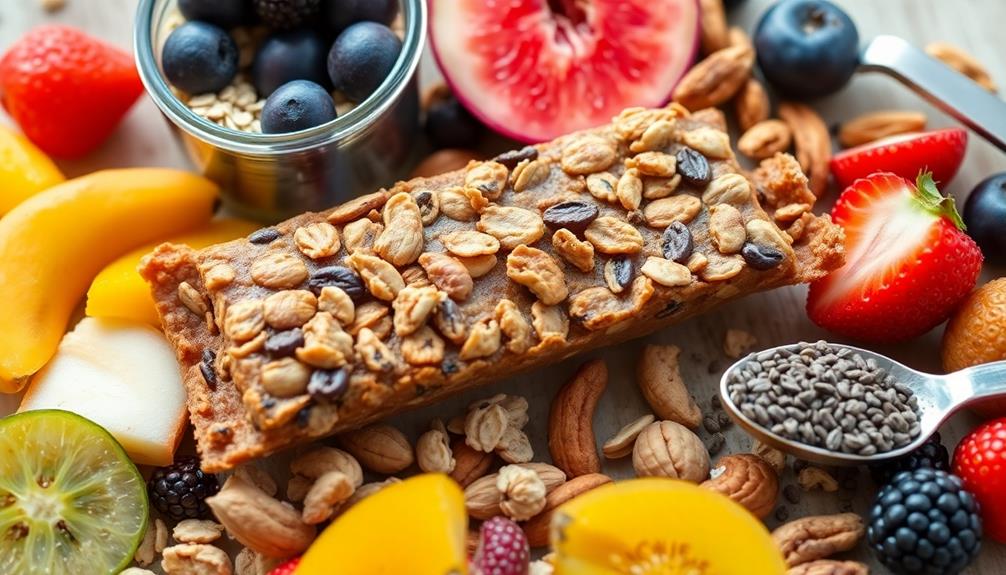
When you choose a Clif Bar, you're getting at least 5 grams of dietary fiber, which can help keep your digestive system on track and make you feel fuller for longer.
Plus, with 10 grams of protein, these bars offer a boost to your energy levels, especially useful before or after a workout.
However, while they pack a decent nutritional punch, they mightn't provide enough protein for a full meal replacement.
Fiber Benefits Explained
Incorporating Clif Bars into your breakfast routine can greatly boost your fiber and protein intake. Each bar contains at least 5 grams of both soluble and insoluble fiber, which is key for digestive health and satiety. The soluble fiber swells in your stomach, helping you feel full longer, while the insoluble fiber adds bulk to your diet, aiding in regular digestion and preventing constipation.
Here's a quick comparison of the fiber and protein content in Clif Bars:
| Component | Amount per Clif Bar |
|---|---|
| Soluble Fiber | 5 grams |
| Insoluble Fiber | 5 grams |
| Total Fiber | 10 grams |
| Protein | 10 grams |
| Fiber Benefits | Digestive health |
Plus, with 10 grams of protein per bar, you get a good source of protein that supports muscle repair and growth. The combination of fiber and protein not only aids in digestive wellness but also helps you maintain steady energy levels, making Clif Bars an excellent choice for those leading active lifestyles.
Protein's Role in Energy
Often overlooked, protein plays an essential role in maintaining energy levels throughout your day. Clif Bars contain 10 grams of protein per serving, which is about 19% of the daily recommended intake for an average adult. This protein primarily comes from soy protein isolate and roasted soybeans, both crucial for muscle repair and growth.
While these energy bars provide a decent amount of protein, they may not be sufficient as a complete meal replacement, where higher protein content would be more beneficial. Additionally, considering the importance of selecting the right cold medication can also influence your overall energy and wellbeing during cold seasons.
Each Clif Bar also packs at least 5 grams of dietary fiber, which promotes satiety and aids in digestive health. This combination of protein and fiber helps you maintain steady energy levels, making them excellent for pre- or post-workout fuel.
However, relying solely on Clif Bars for breakfast mightn't be ideal if you're seeking a more balanced meal.
Immediate Effects on Energy

Although Clif Bars can provide a quick energy boost, their high sugar content may not sustain you through the morning. With around 17 grams of sugar, you're nearly hitting the American Heart Association's daily limit for women and just below it for men. This high sugar content leads to immediate effects on energy, giving you a fast spike that can feel great initially.
However, once that sugar rush fades, you might find yourself crashing and searching for more energy. Since sugar is the first ingredient listed, you might want to reconsider Clif Bars as a regular breakfast option. The added sugars can overshadow the nutritional benefits, making it a less balanced choice.
While the quick energy boost can be useful for athletes during endurance activities, it's not ideal for your everyday breakfast. If you want something more sustaining, consider alternatives like mixed nuts or veggies with hummus.
These options offer similar caloric and protein levels without the added sugars. By choosing lower-sugar foods, you'll likely feel more energized and balanced throughout your morning.
Blood Sugar Response

Many people may not realize how Clif Bars can affect blood sugar levels. When you eat a Clif Bar, the sugar content—nearly 17 grams in total, with 16 grams as added sugars—can lead to a rapid increase in your blood sugar response. This spike might give you a quick energy boost, but it's important to understand the potential long-term effects.
| Aspect | Clif Bar Impact |
|---|---|
| Immediate Blood Sugar Boost | High |
| Insulin Response | Activated |
| Risk of Insulin Resistance | Increased with frequent use |
| Long-term Health Risks | Possible type 2 diabetes |
Consistently consuming products high in added sugars, like Clif Bars, can strain your pancreas as it works to regulate those elevated blood sugar levels. Over time, this process may become less effective, contributing to insulin resistance. Consequently, if you're monitoring your blood sugar levels, especially for overall health, it's wise to reflect on how often you consume these energy bars. Understanding their impact on your body can help you make better breakfast choices.
Meal Replacement Considerations
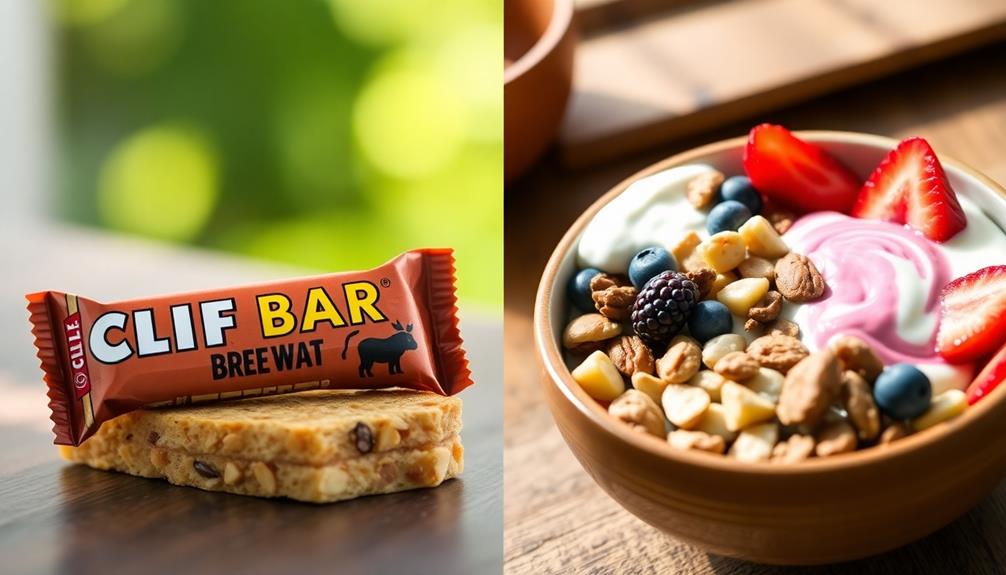
When considering meal replacements, it's crucial to evaluate whether Clif Bars provide the necessary nutritional balance. While they're marketed as energy food, Clif Bars contain about 240 calories each, which may fall short compared to standard breakfasts that offer 300-500 calories.
With only 10 grams of protein, they don't meet the recommended intake for a balanced meal, which should include 10-30% of your daily calorie consumption from protein.
Moreover, the high sugar content of 17 grams, primarily from added sugars, can lead to quick energy spikes without sustaining you throughout the morning. Designed for athletes as pre- or post-workout snacks, Clif Bars focus on providing quick energy rather than nutritional completeness.
Their macronutrient profile—43 grams of carbohydrates with limited fiber and protein—doesn't make them an ideal substitute for a wholesome breakfast.
In short, if you're relying on Clif Bars as a meal replacement, you might want to reconsider. You may not be getting the variety of nutrients your body needs to start the day right.
Opt for a more balanced breakfast that includes proteins, healthy fats, and fiber for lasting energy.
Environmental Impact

While evaluating the nutritional value of Clif Bars, it's also important to contemplate their environmental impact. Clif Bar & Company has made significant strides in sustainability, using 70% certified organic ingredients. This shift helps reduce pesticide and chemical usage, making their products healthier for both you and the planet.
By sourcing 100% of their cocoa from Rainforest Alliance Certified farms since 2012, they promote sustainable farming practices that protect ecosystems and support ethical labor.
Moreover, Clif Bar has eliminated shrink-wrap from its packaging, saving around 90,000 pounds of plastic annually. This move not only reduces waste but also encourages other brands to reconsider their packaging choices.
They're committed to renewable energy, investing in wind energy since 2007 to offset fossil fuel usage.
Clif Bar actively participates in climate policy advocacy through the BICEP coalition, working to influence sustainable practices within the food industry.
These efforts align with your desire for snacks that include healthy fats while also being environmentally conscious. By choosing Clif Bars, you're supporting a company that prioritizes both your health and the health of the planet.
Alternatives to Clif Bars

If you're looking for nutritious alternatives to Clif Bars, several options can provide similar energy without the added sugars. One great choice is mixed nuts. A serving packs a calorie punch and protein, making them a perfect snack for sustained energy throughout your day.
You can also explore different brewing methods that enhance your coffee experience, as caffeine can serve as a great energy booster when paired with a healthy breakfast.
Another excellent option is oatmeal. A bowl of rolled oats can deliver complex carbohydrates and fiber that will keep you feeling full longer. You can enhance its nutritional profile by adding fruits or nuts for added flavor and nutrients.
Veggies with hummus offer a low-calorie, nutrient-dense snack high in fiber and healthy fats, which support better satiety and energy levels.
Greek yogurt topped with fresh berries provides a delicious balance of protein, healthy fats, and antioxidants, making it a nutritious breakfast alternative.
Lastly, consider making a homemade smoothie with spinach, banana, and protein powder. This nutrient-rich option blends carbohydrates, protein, and healthy fats without the high sugar content found in Clif Bars.
With these alternatives, you can enjoy a healthier start to your day.
Frequently Asked Questions
Is It Okay to Eat a CLIF BAR for Breakfast?
It's okay to eat a Clif Bar for breakfast if you need a quick energy boost, but consider pairing it with other nutritious foods to guarantee a more balanced meal that meets your dietary needs.
Are Clif Bars Actually Healthy?
Clif Bars are like candy bars in disguise; they pack high sugar and calories. While they offer quick energy with protein, their nutritional balance often leaves you wanting. Consider them a snack, not a healthy choice.
How Often Should You Eat a CLIF BAR?
You should eat a Clif Bar occasionally, ideally before or after workouts. Limit your intake to avoid excessive sugar, and consider pairing it with protein or healthy fats for balanced energy throughout the day.
Are Clif Bars Easy on the Stomach?
Imagine your stomach as a gentle river. Clif Bars can smooth your journey with fiber and healthy fats, but if you're sensitive to sugars or certain ingredients, they might stir up some rapids instead.
Conclusion
In summary, while Clif Bars can be a convenient breakfast option, it's important to contemplate their nutritional profile. Did you know that a single Clif Bar can contain up to 23 grams of sugar? This might spike your energy temporarily, but it could lead to a crash later on. For a more balanced breakfast, think about incorporating whole foods like fruits or nuts, which provide sustained energy without the added sugars. Your body will thank you!
Recipes and Cooking Tips
How to Make Healthy Breakfast Bowls: Customize Your Way to a Better Morning!
Discover delicious ways to create healthy breakfast bowls tailored to your tastes, and unlock the secrets to energizing your mornings the right way!

Healthy breakfast bowls are a fantastic way to energize your mornings! Start with a base of whole grains like quinoa or brown rice. Then, add your choice of protein—eggs, Greek yogurt, or tofu work well. Layer in colorful veggies, such as spinach and bell peppers, for fiber. Don't forget healthy fats like avocado or nuts for sustained energy. Experiment with spices and toppings like salsa or pickled onions for extra flavor. Prep them ahead of time for quick mornings! You'll soon find endless ways to customize your bowls to fit your preferences and nutritional needs, and there's more to discover!
Key Takeaways
- Start with a nutrient-dense base like leafy greens, quinoa, or brown rice to support energy levels and nutrition.
- Choose a protein source such as eggs, Greek yogurt, or black beans for an energy boost.
- Incorporate a variety of vegetables for added fiber, color, and flavor, such as bell peppers and spinach.
- Experiment with toppings like avocado, salsa, and spices to personalize and enhance the taste of your bowl.
- Prepare components in advance and store them in airtight containers to simplify busy mornings and maintain freshness.
Benefits of Healthy Breakfast Bowls
Healthy breakfast bowls often provide a powerful start to your day by delivering a nutrient-dense meal that balances protein, healthy fats, and carbohydrates. With around 333 kcal, these bowls offer a balanced mix that supports sustained energy levels throughout the morning.
You'll appreciate how they help reduce cravings for unhealthy snacks later in the day, keeping you satisfied and focused.
Meal prepping healthy breakfast bowls can save you time on those busy mornings. By preparing meals in advance, you can simply reheat and enjoy a delicious breakfast without the morning rush.
Plus, the customization options allow you to tailor your bowls to suit your dietary needs. Whether you're vegetarian, vegan, or gluten-free, you can create a nutritious meal that fits your lifestyle.
Incorporating ingredients like kale and tomatoes not only enhances flavor but also adds essential vitamins A and C.
Eggs, on the other hand, provide high-quality protein that contributes to muscle repair and overall health.
Making healthy breakfast bowls a regular part of your routine can lead to better eating habits, setting a positive tone for the rest of your day.
Key Ingredients to Consider
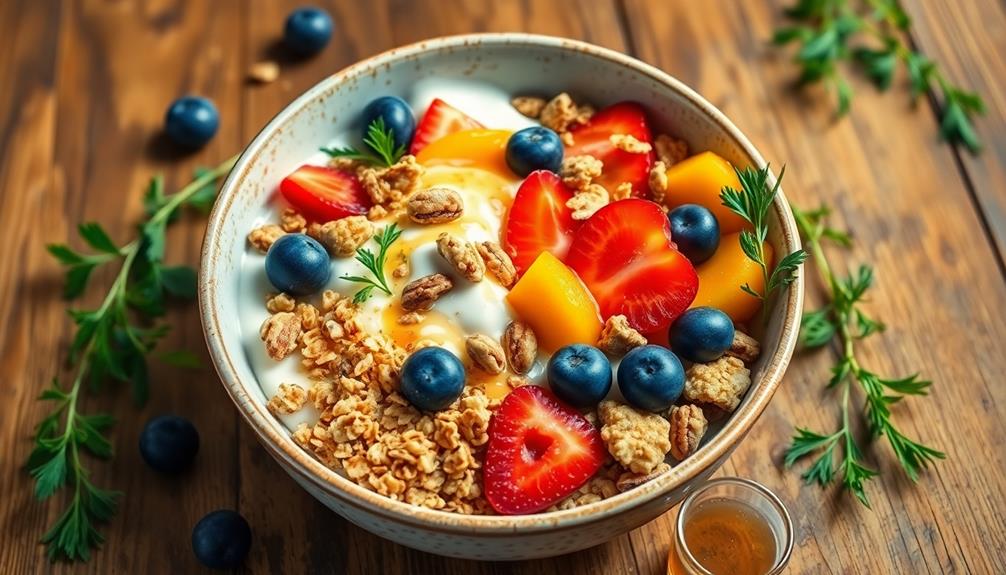
To create a truly satisfying breakfast bowl, it's important to choose the right ingredients that not only taste great but also provide maximum nutrition.
Start by incorporating quality protein sources, which are key for muscle repair and keeping you full throughout the morning. Consider these options:
- Protein Sources: Eggs, black beans, or Greek yogurt can add a nutritious punch to your bowl, ensuring you kickstart your day with energy.
- Vegetables: Leafy greens like kale or spinach, along with colorful veggies such as bell peppers and onions, boost the nutritional value and add fiber to your meal.
- Toppings: Don't forget healthy fats and flavor enhancers! Avocado, nuts, and cheese can elevate your breakfast bowl, while also providing sustained energy.
Step-by-Step Preparation Guide
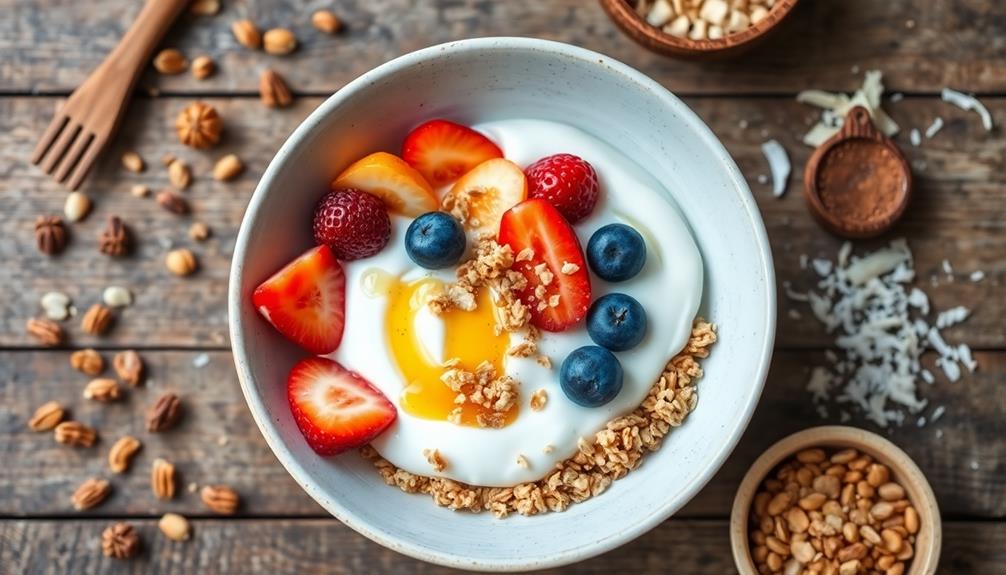
Creating a delicious breakfast bowl involves a few simple steps that lead to a nutritious and satisfying meal. Start by preheating your oven to 400°F.
Prepare your base ingredients, like diced potatoes, bell peppers, and onions, by tossing them with olive oil and seasoning. Roasting these vegetables not only enhances their flavors but also aligns perfectly with Keto Breakfast With Eggs ideas for a high-protein meal. Roast these vegetables for 25-40 minutes until they're golden and crispy.
While the roasted vegetables are cooking, focus on your protein source. Cook eggs or tofu using your preferred method—scrambled, poached, or fried—so they're ready to layer into your breakfast bowl.
Once everything is cooked, it's time to assemble. Begin with a base of leafy greens, like kale or spinach, then layer the roasted vegetables and your chosen protein. Top it off with extras like avocado, cheese, or salsa to enhance flavor. For additional zest, sprinkle in spices such as paprika or everything bagel seasoning.
If you're planning for the week, divide the components into separate containers for an easy meal prep breakfast. Store them in the fridge for up to three days or freeze them for up to two months, ensuring you can enjoy a healthy breakfast whenever you want!
Customization Ideas for Everyone
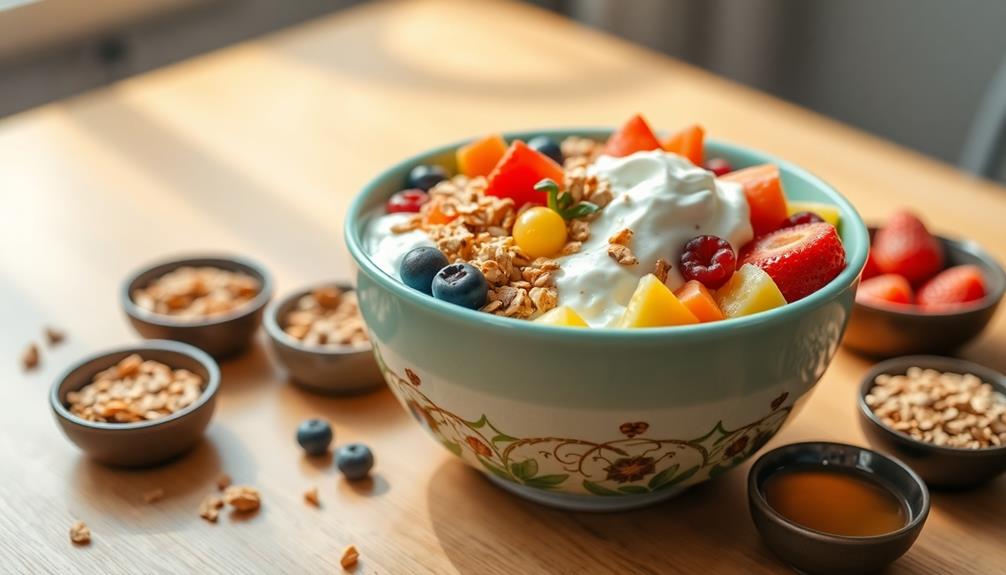
Breakfast bowls can easily be tailored to suit everyone's tastes and dietary needs. With a few customization ideas, you can create a delicious and nutritious start to your day. Here are three ways to make your breakfast bowls uniquely yours:
1. Mix Up Your Protein Options: Swap out traditional eggs for scrambled tofu or black beans. This vegan option still packs a protein punch while keeping it wholesome.
For those following a keto diet, consider adding easy keto breakfast ideas like Greek yogurt or cheese for additional protein.
2. Incorporate Seasonal Vegetables: Add bell peppers, onions, or zucchini to enhance both the flavor and nutritional profile of your bowl.
Seasonal vegetables keep your meals fresh and exciting. Don't forget to explore options like cauliflower, which can serve as a versatile side dish.
3. Experiment with Toppings: Layer on fresh avocado, salsa, or pickled red onions to cater to your taste preferences.
These toppings bring extra texture and flavor to your breakfast bowls.
Don't forget to adjust the base of your bowl, too! Quinoa or brown rice can replace potatoes for a whole grain boost.
Meal Prep and Storage Tips
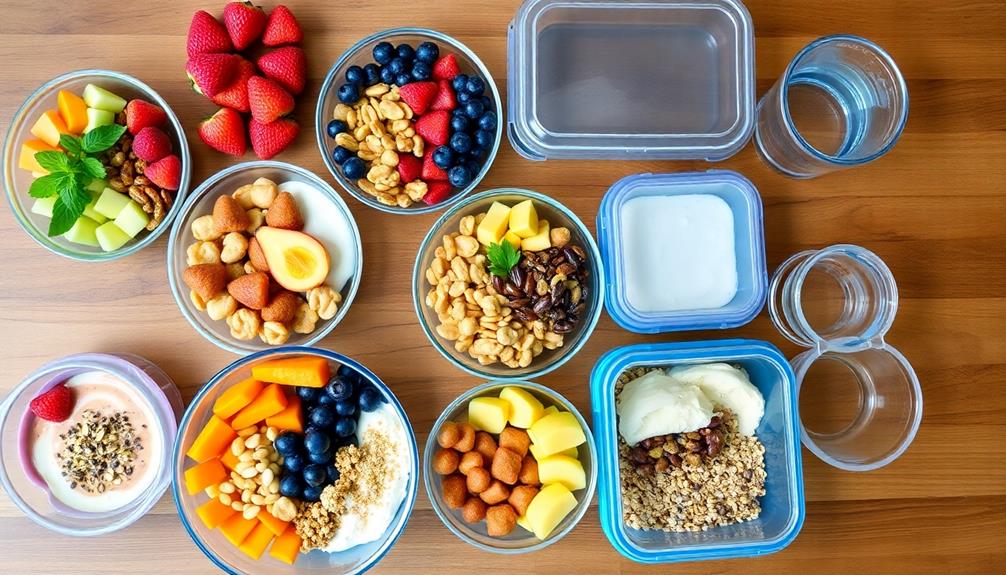
To make your breakfast bowls last throughout the week, use meal prep containers to keep each component separate and fresh.
When you're ready to enjoy them, remember to reheat only what you need, ensuring every bite tastes just as good as the first.
Meal Prep Containers
Meal prep containers are essential for keeping your healthy breakfast bowls fresh and delicious throughout the week. By using the right containers, you can maintain ingredient integrity and enjoy your meals at their best.
Here are three tips for choosing the best meal prep containers:
- Opt for Airtight Containers: These will keep your ingredients fresh for up to three days in the fridge or 1-2 months in the freezer. Airtight containers prevent moisture from ruining your meals.
- Use Glass Meal Prep Bowls: They're perfect for easy transport and microwave reheating. Plus, glass doesn't stain or retain odors, making them a healthier choice for your breakfast bowls.
- Label and Organize: Label your containers with dates to track freshness and avoid waste. Divide your components into separate containers, and keep side sauces and toppings on the side to prevent sogginess.
This approach not only preserves texture but also makes reheating a breeze.
Reheating Guidelines
Properly reheating your breakfast bowls guarantees you enjoy their flavors and textures just as intended. Start by storing your prepared bowls in airtight containers in the fridge for up to 3-4 days.
When you're ready to dig in, simply microwave each bowl for 1-2 minutes, stirring halfway through to assure even warming. This method helps revive the freshness that you'll love.
If you've opted to freeze some bowls, allow them to cool completely before sealing them. These frozen bowls can last 1-2 months in your freezer.
When reheating from frozen, microwave on 50% power for about 1.5 minutes. Stir, then continue heating, checking every 30 seconds until they're warmed through. This step prevents any hot spots and assures a consistent temperature.
To keep your avocado from browning, add it just before serving. If you've prepped in advance, consider using a splash of lemon juice for that fresh taste.
Following these reheating guidelines will help you enjoy your healthy breakfast bowls just the way you intended, maximizing both flavor and nutrition. Happy eating!
Flavor Enhancements and Toppings
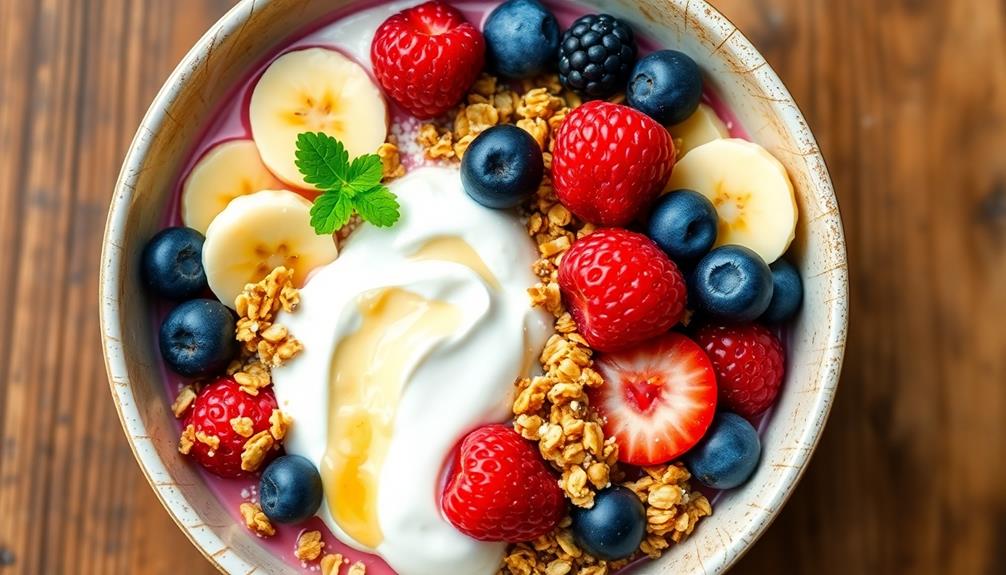
To make your breakfast bowl truly shine, consider adding toppings like avocado, salsa, or even a drizzle of hot sauce.
Incorporating ingredients rich in antioxidants, such as beets or celery juice, can enhance both flavor and nutritional value high levels of antioxidants.
Spice it up with unique seasonings or fresh herbs that match your taste, and don't shy away from experimenting with different vegetables for added texture.
With the right combinations, you can transform a simple bowl into a flavorful and nutritious meal that keeps you energized all morning.
Topping Ideas and Combinations
Elevate your breakfast bowl by mixing in a variety of flavorful toppings that can transform a simple meal into a delightful experience. The right toppings not only enhance flavor but also boost nutrition, making your mornings even better.
For example, incorporating toppings that are rich in antioxidants can help support your immune system, especially during cold seasons when cold medications overview may be needed.
Here are some topping ideas to contemplate:
- Avocado & Hot Sauce: Creamy avocado adds healthy fats, while a drizzle of hot sauce brings the heat, creating a perfect flavor balance.
- Shredded Cheese & Spices: Sprinkle some shredded cheese, like cheddar or feta, for richness and texture. Pair it with spices like everything bagel seasoning or red chili flakes for a bold kick without added calories.
- Nuts or Seeds: Chia seeds or almonds offer a crunchy texture and extra fiber, further enhancing the nutritional profile of your breakfast bowl.
Don't forget about pickled red onions for a tangy twist or sauerkraut for a probiotic boost.
With these topping combinations, you'll not only enjoy a delicious breakfast but also fuel your day with essential nutrients. Experiment with different toppings to discover your favorite flavor profiles!
Spice It Up
Adding a bit of spice can take your breakfast bowl from ordinary to extraordinary. To truly spice it up, consider incorporating spices like everything bagel seasoning, paprika, or cayenne pepper to add that perfect kick.
Don't forget to season with salt to enhance all those flavors! You can also boost your morning energy with essential oils for respiratory health, which can help clear your mind and prepare you for the day ahead.
You can also add potatoes for a hearty touch, making your bowl more satisfying. Toppings such as avocado not only provide healthy fats but also a creamy texture that complements your spices beautifully.
Experiment with various cheese options, like feta or even dairy-free cheese, to introduce different textures and flavors that elevate your meal.
For an extra flavor boost, add salsa or hot sauce to your breakfast bowl; this can really tailor it to your spice preference. Fresh herbs like cilantro or chives can also work wonders, adding a burst of freshness and vibrant color to your dish.
Creative Breakfast Bowl Variations

Breakfast bowls offer endless opportunities for creativity, especially when you mix and match various ingredients. You can easily customize your breakfast bowls to suit your taste and dietary needs.
Here are three delicious variations to inspire you:
- Savory Sweet Potato Bowl: Start with a base of roasted sweet potatoes, then add colorful vegetables like bell peppers and spinach. Top it off with scrambled tofu for a hearty protein source, and drizzle with your favorite sauce for extra flavor.
- Fruity Yogurt Bowl: Choose overnight oats as your base, and layer in Greek yogurt for creaminess. Pile on fresh fruits, like berries or bananas, and sprinkle with nuts or seeds for crunch. This bowl combines sweetness with a satisfying texture while providing essential nutrients.
- Tangy Veggie Bowl: Begin with quinoa or brown rice as the base. Load it up with vibrant vegetables, and swap traditional toppings for pickled red onions or sauerkraut. These unique additions not only enhance flavor but also support gut health.
Experimenting with these variations will keep your breakfast exciting and nutritious!
User Experiences and Feedback

Many users love the flexibility of customizing their breakfast bowls, which caters to diverse dietary preferences and enhances meal satisfaction. You can easily mix and match proteins, vegetables, and toppings to suit your taste, making breakfast exciting.
User experiences reveal that this personal touch not only elevates the meal but also encourages a sense of ownership in your nutrition.
Many families appreciate the ease of meal prep that breakfast bowls offer. By prepping ingredients in advance, you can reduce morning overwhelm and streamline your routine. This simplicity makes it easy to whip up a nutritious start to your day, even when you're short on time.
Community engagement plays a significant role in the popularity of breakfast bowls. Users frequently share tips and experiment with flavors, leading to unique recipe variations that keep things fresh.
Feedback often highlights the nutritional benefits, with many noting how the high protein content and colorful veggies help them feel energized and focused throughout the day. With endless possibilities for customization, you'll find that breakfast bowls not only satisfy your hunger but also cater to your health goals.
Frequently Asked Questions
How Can You Build a Healthy Breakfast What Would It Look Like?
To build a healthy breakfast, start with a protein source like eggs or tofu. Add nutrient-rich veggies, healthy fats, and a carb for energy. Customize with toppings for flavor, crunch, and extra fiber. Enjoy!
What Is the Healthiest Breakfast Dish?
The healthiest breakfast dish balances protein, healthy fats, and complex carbohydrates. Think eggs with avocado and whole grains, topped with leafy greens and berries. This combination fuels your day while providing essential nutrients for overall well-being.
Are Breakfast Bowls Healthy for You?
Absolutely, breakfast bowls are healthy for you! They're packed with nutrients, protein, and healthy fats, giving you energy. Plus, you can customize them to fit your dietary needs, making breakfast both fun and nutritious.
How Do You Make a Healthy Breakfast Plate?
To make a healthy breakfast plate, start with protein like eggs or tofu, add colorful veggies, include healthy fats like avocado, toss in whole grains, and spice it up with your favorite toppings for variety.
Conclusion
Crafting your own healthy breakfast bowl is like painting a masterpiece—each ingredient adds color and flavor to your morning. With just a little creativity and planning, you can whip up a nutritious meal that fuels your day. Don't hesitate to experiment with different ingredients and toppings; the possibilities are as endless as your imagination. Start your mornings the delicious way, and watch how a simple bowl can transform your day!
-

 Restaurant and Fast Food Breakfast3 months ago
Restaurant and Fast Food Breakfast3 months agoHardee's Breakfast Hours Revealed – Don’t Miss Out!
-

 Cultural and Regional Breakfasts3 months ago
Cultural and Regional Breakfasts3 months agoClassic American Breakfasts That Will Make Your Morning!
-

 Catering and Delivery3 months ago
Catering and Delivery3 months agoBreakfast Delivery Options That Will Blow Your Mind!
-

 Local Breakfast Spots3 months ago
Local Breakfast Spots3 months agoBest Breakfast Spots in Las Vegas You Have to Try!
-

 Recipes and Cooking Tips3 months ago
Recipes and Cooking Tips3 months agoThe Ultimate Breakfast Casserole With Biscuits Recipe!
-

 Cultural and Regional Breakfasts2 months ago
Cultural and Regional Breakfasts2 months agoTaiwanese Breakfast Dishes You Have to Try!
-

 Health and Nutrition3 months ago
Health and Nutrition3 months agoHigh-Calorie Breakfasts for Those Who Need the Boost!
-

 Health and Nutrition3 months ago
Health and Nutrition3 months agoRevolutionizing Mornings: Ryze Organic Mushroom Coffee
